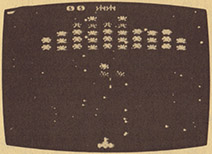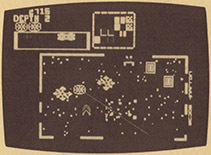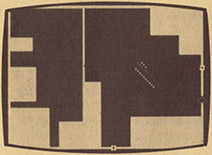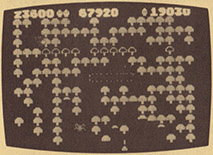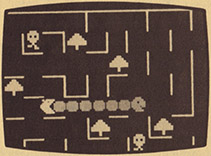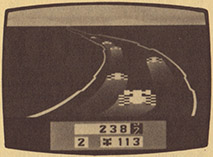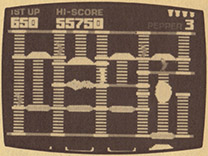
supergaming
The Best and the Brightest
Theodore Sturgeon, the writer of horror fiction, some years ago coined Sturgeon’s Law; it stated, quite simply, that ninety percent of everything is junk. (Who would know better than a writer of horror?)
In this issue we have already detailed some of the disasters and knock-offs that have prevailed in the videogame industry. But in the interest of balance—and to prove that we are not immune to positive reinforcement—we now bring you our opinions of which are the best game systems, the best game companies, and the best games for each system.
Contrary to Sturgeon’s Law, most of what has been produced in this field is not pure junk; it is only when one company sets a standard for excellence that the previous efforts, or the substandard newer ones, begin to lose their lustre. This industry has grown at a dizzying pace; new standards have been set amost weekly. In such an atmosphere, the efforts of well-meaning and innovative people all too often are denigrated, misinterpreted, forgotten or dismissed.
There. We have memorialized the limbo dwellers: Elsewhere we have skewered and basted the snake-oil salesmen. Now, on to the best and the brightest!
To begin with the various game systems, we have determined that the number one game system, bar none, is the Atari 5200. Yes, we realize that back in July we gave the nod to Coleco’s ColecoVision, but after giving both systems six months to “strut their stuff”, we feel the smart money is now on Atari’s 5200. The reasons are two-fold: hardware and software. On the hardware side, the Atari’s controllers are far superior to all of the other systems. While there are better controllers that are made for other systems (which will be discussed later) the 5200 original controllers are the best that can be used with the 5200.
Beyond this, the actual look of the game unit is much more appealing than its competitors. The 5200 has that trim and sexy feel of the future. Also, games take less time to “load up.” When the game is plugged in and the system turned on, you will be subjected to only about five seconds of the Atari logo and game title, as opposed to about twice that time for ColecoVision.
In terms of software, we have noticed a marked sobriety and a greater nuance and depth to the 5200 games. The colors are subdued, not distracting. Also, there are more of the popular arcade games on Atari software than on any other systems. The 5200 games are fast, challenging and there is a true variety in the library thus far available.
Number two, and not really that far behind, is ColecoVision. Advantages for this system are its expanded memory capacity and its sophistication in electronic design. The system also offers a variety in both hardware and software. There is something in this system for everyone’s tastes. While its expandibility and various peripherals should make it the number one game system, they unfortunately do not. It almost seems that Coleco’s hardware barrage has become more of a marketing come-on than anything else.
People who are impressed by a variety of hardware are sure to disagree with us on this point, but very often, simple is better. With all of its vaunted hardware and the switching around of all the peripheral controllers and whatnot, there is far more that can go wrong and break down with this system. And once all these peripherals are added (which do not greatly enhance the software library), the less expensive ColecoVision will wind up actually costing far more than the 5200.
The third best system is the now-defunct (but still kicking) Astrocade system. (Incidentally, the fact that Astrocade is now out of business is the only reason that it is in third, rather than second place.) Still, ignoring this small detail, it had all the other game systems beat by light years. Not only does it have three games and a calculator built into the console, all of its games are totally original. There are no licensed games or knock-offs among their library. The controllers are in all probability the best ever designed. They are pistol grips, and thus allow for greater game control.
The fact that the system is no longer on the market should not dissuade people from seeking out and finding one. They can be picked up for a song, assuming of course that they can be found. Astrocade was a small company and simply ran out of money. They did not have a major corporation backing them (Atari has Warner, ColecoVision/Coleco, Intellivision/Mattel, and Odyssey has Magnavox/NAP); when they went up against these corporate giants, they were simply out-gunned. There is a postscript to their story, as there is still a company or two manufacturing games for this system.
Fourth in line is Mattel’s Intellivision. One of the major reasons for their fourth place status is their horrible keypad. There is no joystick built into this pad, it is merely a pressure-sensitive switch that simply does not make it where videogamers are concerned. The pressure pad does not allow for the precision gameplay demanded by videogame afficionados.
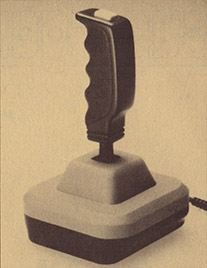
A further major problem with both Intellivision One and Odyssey game systems is that their controllers are not detachable: if players wish to use one of the independently manufactured controllers, they are unable to. Should the unthinkable occur, should the controller break, the entire system must be shipped back to the factory for repairs. Most gamers would probably be lost at sea without their beloved unit for six to eight weeks.
As far as software is concerned, there is just not enough action software available for the Intellivision. To be sure, they do offer the very best in sports games, but video sports fanatics are far fewer in number than anyone would care to admit. What gamers truly want are SF shoot-‘em-ups and slick strategy games. In the long run Mattel’s attempts to provide this type of game do not hold up.
Close behind the Intellivision is the 2600 with the Supercharger adapter by Starpath. For anyone who has the 2600 and not the Supercharger, we highly recommend the addition of this peripheral. Games for the Starpath-enhanced 2600 will most assuredly keep the dust off your VCS. Even without the Supercharger, the 2600 is a very good system, if only because of the vast amount of software available for it. Especially now, when so many stores are unloading their overstock. by drastically cutting the prices on them (to under four dollars apiece in some cases.).
Last, and certainly least among the supersystems, is the Odyssey 2, if only because of NAP’s inability to decide exactly what it is they are doing. With their plans for Odyssey 3 scuttled in the US (it will still be released in Europe) and their cancellation of three major game cartridges (Lord of the Dungeon, Power Lords, and Pursuit of the Pink Panther), it is quite possible that the next company to go under will be Odyssey.
Now let us briefly gaze over the river of sticks. Of all the super joysticks currently on the market, Wico has the very best. Their top of the line is The Boss. This joystick features a firebutton in the top of the joystick, and sturdy 360 degree control and quick responses. After Wico comes D-Zyne and their products for Intellivision and ColecoVision.
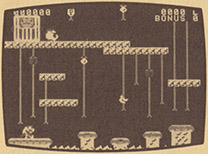
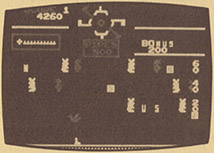
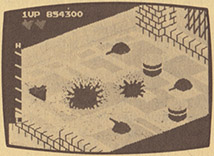
A distressing number of the sticks we’ve tested are about as durable as an M&M.
For servicing, the number one position once more goes to Atari With their nationwide network of service centers, no one can hold a candle to them. (Editor’s note: At presstime, Atari announced that they would be closing a number of their service centers. The facts, and their impact, still being unclear, we will stand unsteadily on our judgement.)
Since they are so far out in front of the pack, everybody else rates a poor man’s second. In a market like this serviceability is half the battle. For, while an Intellivision or ColecoVision may in fact be a far better system than the 2600, if you can get your VCS repaired in time for the weekend, but have to ship your Intellivision to the other end of the state for a month and a half, more people are likely to choose the 2600.
As far as the games themselves go we feel that it would be unfair to arbitrarily rate the games regardless of their game system. Thus we decided to list the best five games of each system, regardless of how much better any one game from one system is than that of another game from another system. Therefore, we will begin with the number one Atari 5200.
Topping the list here is Space Dungeon by Atari. To quote reviewer Jim Clark, “This is indeed the ultimate space shoot-‘em-up.” In this game you travel through various sectors of space, battling a veritable armada of deadly ET’s while you gather various valuable artifacts. For the best in abstract videogaming, do not overlook Qix, in which the player divides up the playfield while pursued by a spark.
Also from Atari is Centipede. This game, again from the arcades, is very fast moving and extremely precise in gameplay. From CBS comes Wizard of Wor, which we felt was the best maze game for the 5200. With this choice we mean no disrespect for the much-touted Pac-Man. It is the general opinion around the office that, while Pac-Man is a nice game, it is vastly overrated. The last game that we will mention for the 5200 is Galaxian. Though Galaxian is similar in play to its predecessor, Space Invaders, it offers a greater variety in action and tactics.
Moving along to ColecoVision, their top five is led off with Ladybug, an excellent maze game that is fast paced and fun to play. The only non-Coleco game on this list is Q*Bert. According to our reviewers, Q*Bert is “just about perfect.” A unique cartridge and a fine addition to the game system. Zaxxon is also very true to its arcade inspiration; its 3D simulation and intricate battlefield make it one of the best home games ever designed.
Whereas Zaxxon makes our list due to its superb graphics, Carnival is here for the opposite reason. The graphics are not nearly as realistic or dimensional as are the graphics in Zaxxon, but Carnival is such a dandy of a videogame that we felt it demanded to be mentioned.
Next up probably should have been Donkey Kong, but its offspring had so much better graphics that it aced its dad out. Donkey Kong Jr. is very different from Donkey Kong Sr. and yet it captures that same feeling. Jr. is not merely the same game with just a few new wrinkles thrown in (as all of the Pac-Man derivatives seem to be). All-in-all, Donkey Kong Jr. is a splendid cartridge for the whole family.
From the Astrocade system virtually all of the games are excellent, and worth picking up. Still, the more notable games of the line include Space Fortress, Galactic Invasion, and The Incredible Wizard.
On the Intellivision system, BurgerTime is without a doubt the finest game for this system. BurgerTime is a delight to play; it involves a certain degree of strategy and it is just plain fun. Shark! Shark! is an original game that the family can play and enjoy. Demon Attack by Imagic is the only non-Mattel game on this list. As good as the VCS version of this game was, the Intellivision one is that much better.
As noted before, the Intellivision system is better known for its sports games than its space adventures. It is for this reason that we are including NFL Football on our “best of” list for this system. Its ability to program plays won it our Vista award for best Intellivision sports game of 1983. Lastly for Intellivision is Space Battle. In this game the player is required to monitor action that is simultaneously happening on two screens.
For the 2600, all of the games for the Starpath Supercharger merit recommendation. The best five non-supercharger games are as follows. Freeway, from Activision, demands that the player get that chicken across that road. Freeway is by far a more exciting and involving game than Frogger. Activision’s Kaboom! is next, with a crazed bomber who wishes to do you some serious harm. The third game on our VCS list will probably shock many of you. The game is Adventure, from Atari.
This is one of the earliest “quest” games for the VCS and therefore contains very sparse graphics; still, few of its descendents can match its engaging gameplay. Again from Activision comes the very exciting Enduro. This point-of-view race game unquestionably blows the doors off all comers. There is no other game that contains both the feel and power of racing that this one does. Atari brings up the number five position with their still-great Missile Command.
For the Odyssey system the best games are their Master Strategy series, but we felt that we had to dismiss them from our survey. They have the unfair advantage of being both board games and videogames. However, they all come highly recommended by those polled. UFO leads off the list as our favorite, with Killer Bees close behind. Cosmic Conflict is third, with Invaders from Hyperspace fourth. Rounding up this list is, KC’s Crazy Chase. Though it is not as good as KC Munchkin, it deserves to be here. If you are able to find a copy of the Munch kin version around, scoop it up, as it is a great maze game.
Well, there you have it, the best and the brightest videogames and game systems available. But we felt that there was just one more category that should be considered, and that was an overall rating of the various software manufacturers. We gauged all of the companies based upon how well they were able to consistently produce interesting games. Since the 2600 system has been around for the longest time, there was obviously a greater variety of companies and software to choose from for the purpose of evaluation.
With the 2600 as a base, we determined everyone’s position by using a percentage of good games. versus lesser games. Here, our only consideration was quality, and not price. For some would argue (and did) that a mediocre M-Network game at $5.00 is better than a good Activision game priced at $30.00
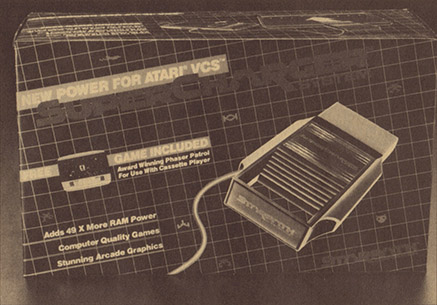
Should a consumer buy a game “blind”, that is to say with no prior knowledge of the game, but only the manufacturer, (s)he has the best chance of getting a good game with Activision. Approximately 85% of all Activision games are quality. Imagic follows with 70% of their games worth buying.
The defunct Telesys games are next in line, with about 60% of their output being recommendable. Data Age (which also went Chapter 11) also runs about 60%. Midway down the list is the giant Atari at 50%. Atari has such a low rating because, while they have produced a far greater wealth of games, they have had as many turkeys as hits. Perhaps if some of the other companies had produced as many games as Atari, they would also have a lower percentage of hit games.
Parker Brothers and CBS tie at 35%, while Apollo Games comes in at 30%. Just under them at 25% is Tigervision. With a whopping 20% are three companies: M-Network, U.S. Games, and Spectravideo. At the bottom of the heap are the 20th Century Fox Games of the Century and Zimag at 10%. Any company not mentioned in this survey either does not deserve a rating, because they scored so low, or did not produce enough games to accrue an accurate score.
With many of the early leaders in the field dropping by the wayside, those that survive the videogame wars will surely be the best of the best, and will produce some fantastic games! Like the movie business, there will be fewer, but more carefully prepared, offerings. Unlike the movie business, the denominator will not be the “lowest common”…but the “highest possible.”
Does that sound overly optimistic? Perhaps it is. But we have the highest hopes for the future of videogaming; we take a great deal of pride in its past.
Videogaming will continue to bring families and friends together for an active, rather than a passive purpose. Videogames provide the handicapped and the institutionalized with a measure of relief—call it an escape if you like—an outlet for energies, a goal toward which to work. Video or computergames can become the equalizer between children of unequal athletic or academic abilities. They provide a painless first step into the world of computers.
And they’re fun. Or at least, we at VCI are sure that the best and the brightest will continue to be.
Source Pages




